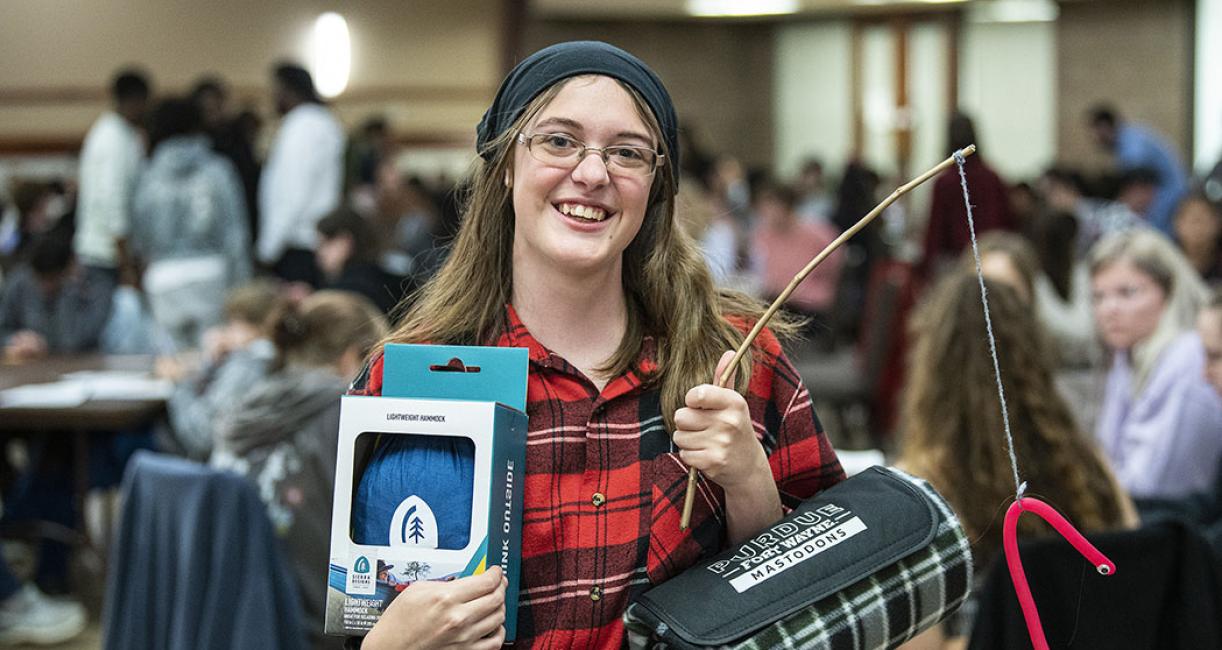


Recent grad thrives with positive attitude despite health challenges
By Blake Sebring
May 30, 2023
Though her petite frame looks unlike any musclebound superhero, Lillian Stotlar, B.A. ‘23, displays more strength and resiliency than most of them could dream of.
The recent Purdue University Fort Wayne graduate with a degree in art and design has a personal issue she needs to share with those who become friends. She knows it’s better to get it out in the open rather than wait for a particular right time, but it’s not an easy subject to insert into conversations.
For the past seven years, Stotlar has experienced panic attacks, essentially the body’s fight or flight response with adrenaline immediately pumping to create debilitating circumstances. As a person realizes one is happening, it’s too late to counter, and they must ride through the process.
Stotlar has also experienced what doctors have told her are five strokes—three over the last year alone—though there are no lasting effects as usually defined by a stroke. During her episodes, the left side of her body becomes numb briefly.
Imagine the absolute fear of experiencing either a panic attack or a stroke the first time. What is happening? Is this a heart attack or a nervous breakdown? How long will it last? Will I survive?
And maybe the worst circumstance for Stotlar is that each can happen with little or no warning, no matter the circumstances. They might happen in the next hour, the next week, or at any time in the future. That’s why she needs to inform those close to her about the possibility so they are not overly alarmed at the moment.
“With the strokes, I can feel them coming on because they are one side of my brain,” Stotlar explained. “I’m able to move to lie on one side of my body. With a panic attack, I’m usually not able to move or talk, but I can communicate by tapping with my hands to let people know.”
She may look incapacitated and limp during a panic attack, but Stotlar is fully aware and answers yes/no questions by tapping.
“She kind of acts tired, and she’ll know something is a little off, but she can’t tell what until it happens,” said nursing major and roommate Kylie Webb. “She’ll get someone’s attention and say, ‘Attack happening,’ and we’ll walk her through it and let her know we’re still there. It’s a little nerve-wracking, but if you keep yourself calm, the entire situation goes a little smoother. You tend to make rash decisions if you are not as calm as you need to be.”
Amazingly, Stotlar usually recovers quickly from either event and resumes her day. Following longer episodes, she may be wiped out physically and need more recovery.
After experiencing her first stroke last year while alone in her PFW housing bedroom, Stotlar did not immediately seek medical attention, but she has since. Doctors have been unable to find a cause despite brain scans, heart tests, adrenal gland tests, and blood work. Partly because there are no blockages, arrhythmia, or clots, the causes might be psychological.
Stotlar communicates daily with three nurses, regularly meets a therapist, made a strong connection with a neurologist, and sees her doctor at least every few months. She wore a heart monitor for a week, but every result was negative, even when she experienced a panic attack.
“My doctor and therapist have always backed me up on my dreams and constantly tell me that if I feel like it’s coming on, I just need to sit back and relax for a bit,” Stotlar said. “They have encouraged my journey so far, and I know professionals are looking out for me and seeing the best in my opportunities.”
Whenever starting a class, Stotlar would email professors about her situation. Sometimes, she’d excuse herself from class to sit in a quiet area while the panic attack passed and return afterward.
“Of course, I have these, but there are others who have it way worse,” Stotlar said. “There’s always a way to stay positive through all of it. I know they are going to pass eventually, and with help and good people beside me, I know I’m going to get through it.”
Another unique thing about Stotlar is she’s an avid walker and runner, maintaining condition to do professional modeling, and has never experienced a problem while being physically active or driving. She rarely consumes caffeine because it can act like a trigger, speeding up her heart rate and tricking her mind into believing she’s having a panic attack.
“I am constantly searching and looking for answers every week, and I hope someday in the future we can find some new answer about what is happening to me,” Stotlar said. “But until that day arrives, I know I’m going to get through this journey with my friends, faith, and family. Being surrounded by people who constantly look out for me and help me through this journey has been a blessing.”
But why share the story so publicly, including having it be part of her recent Top 50 recognition?
“I love being open about this situation with other people because I feel like the more people who are aware that this is a real thing and how badly it can affect a person, the better they understand how they can help in situations like that,” Stotlar said. “It’s scary to go into these things, and I deal with it by being as positive as possible, keeping an open and optimistic mindset, and just remembering it’s going to pass, and I’m going to be OK.”
According to the American Stroke Association, strokes are the No. 5 cause of death and the leading cause of disability in the United States. They can be caused by a clot obstructing flow to the brain (ischemic stroke) or by a blood vessel rupturing preventing blood flow to the brain (hemorrhagic stroke). A transient ischemic attack, also called a TIA or “mini-stroke,” is caused by a temporary clot. One in five women will suffer a stroke.
May is American Stroke Month. More information, including the warning signs, is available through the American Stroke Association.




